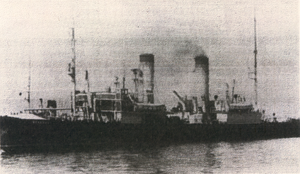Lenin (1916 icebreaker)
 The icebreaker Lenin, former St. Alexander Nevsky.
| |
| History | |
|---|---|
| Name | HMS Alexander |
| Builder | Armstrong Whitworth, Newcastle upon Tyne, England |
| Yard number | A/W 905 |
| Laid down | June 1916 |
| Launched | 23 December 1916 |
| Completed | June 1917 |
| Commissioned | September 1917 |
| Decommissioned | 1919 |
| Fate | Handed over to White Russian forces, 1919 |
| Name |
|
| Namesake | Vladimir Lenin |
| Acquired | c.1919 |
| Out of service | 1968 |
| Fate | Scrapped, 1977 |
| General characteristics | |
| Type | Icebreaker |
| Tonnage | 3,375 GRT |
| Displacement | 5,600 tonnes |
| Length | 85.6 m (281 ft) |
| Beam | 19.5 m (64 ft) |
| Draught | 6.24 m (20.5 ft) |
Lenin (Russian: Ленин) was a Russian icebreaker originally built in England for the Russian Empire. Launched in 1916, before going into service for Russia, the ship first served in the Royal Navy during the Allied intervention in the Russian Civil War. It was eventually acquired by the Soviet Union and served through World War II, and was finally scrapped in 1977.
Ship history[]
The ship, ordered by the Russian Empire, was laid down in June 1916 by Armstrong Whitworth at Newcastle upon Tyne as the St. Alexander Nevsky, after Russian statesman and military hero Alexander Nevsky.[1] Her construction was supervised by Russian naval architect and author Yevgeny Zamyatin.[2] The ship was launched on 23 December 1916, and completed in June 1917. By then though the Russian Empire had ceased to exist following the February Revolution, and the ship was requisitioned by the Royal Navy and commissioned as HMS Alexander in September 1917. Alexander served in the North Russia campaign, and was handed over to White Russian forces when the British withdrew in October 1919.[1]
In Russian service[]
The ship must have been soon taken by the Bolsheviks, for in 1921 the Norwegian sailor and Arctic explorer Otto Sverdrup commanded the ship, now named Lenin, at the request of the Soviet government, when he mounted his fourth and last expedition in Arctic Siberian waters. He led a convoy of five cargo ships on an experimental run through the Kara Sea to the mouths of the Ob and Yenisei Rivers. The ships reached their destinations and returned safely. This was considered an important step in the development of the Kara Sea sector of the Northern Sea Route.[3]
In 1937 Lenin was trapped in ice. She and her convoy of five ships spent an enforced winter in the Laptev Sea. They were finally rescued by the icebreaker Krasin in August 1938.[4]
During World War II the Lenin took part in Russian convoys in the Arctic.[1] In 1942 the Lenin was part of a convoy spotted at the Mona Islands in the Kara Sea by a Kriegsmarine Arado Ar 196 during Operation Wunderland. The heavy cruiser Admiral Scheer rushed to find it, but bad weather, fog, and ice saved Lenin from destruction.[5]
The Lenin continued in service during the Cold War, but in 1957, when the nuclear-powered icebreaker Lenin was launched, it was renamed Vladimir Ilich Lenin. The ship was hulked in 1968, and finally scrapped in 1977.[1]
In popular fiction[]
In his dystopian novel We, Zamyatin refers to the specifications of St. Alexander Nevsky in the names of some of his characters.[2]
The ship appears in Dziga Vertov's 1926 film A Sixth Part of the World.
See also[]
References[]
- ^ a b c d "Requisitioned Auxiliary - Alexander". historicalrfa.org. 2012. Retrieved 16 June 2012.
- ^ a b Myers, Alan. "Zamyatin in Newcastle". Archived from the original on 27 September 2007. Retrieved 16 June 2012. (updates articles by Myers published in Slavonic and East European Review)
- ^ Barr, William. "Arctic Profile : Otto Sverdrup (1854-1930)" (PDF). Arctic. Arctic Institute of North America. 37 (1): 72–73. doi:10.14430/arctic2169. Retrieved 16 June 2012.
- ^ Barr, William (March 1980). "The Drift of Lenin's Convoy in the Laptev Sea, 1937-1938" (PDF). Arctic. 33 (1): 3–20. doi:10.14430/arctic2543. Retrieved 26 July 2008.
- ^ "Operation Wunderland, August 1942". allworldwars.com. 2011. Retrieved 16 June 2012.
- 1916 ships
- Ships built on the River Tyne
- Auxiliary ships of the Royal Navy
- Icebreakers of the United Kingdom
- Icebreakers of Russia
- Icebreakers of the Soviet Union
- Laptev Sea
- Kara Sea
- Ships built by Armstrong Whitworth